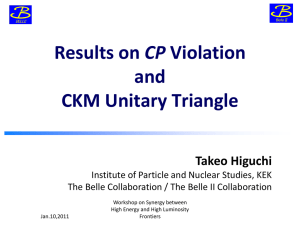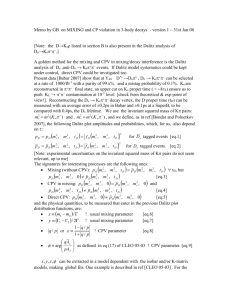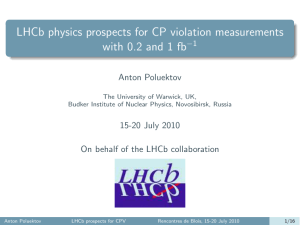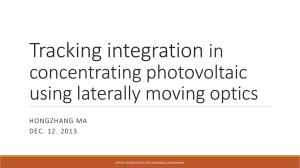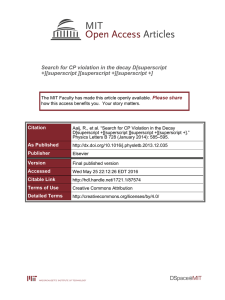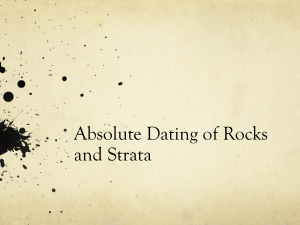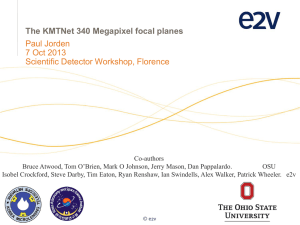ppt
advertisement
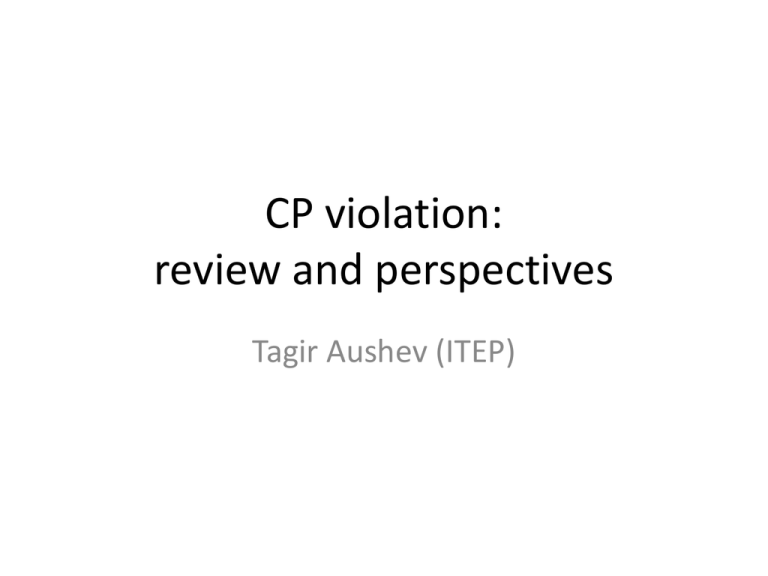
CP violation:
review and perspectives
Tagir Aushev (ITEP)
50 years of CP violation
• This year, 50th anniversary of CP violation:
– In 1964 J. H. Christenson, J. W. Cronin, V. L. Fitch, and R. Turlay
discovered CPV in the neutral long-lived kaon system: KLπ+π-
J. Cronin
V. Fitch
1980
Kobayashi-Maskawa model
• In 1973 to explain CPV in kaons M.Kobayashi and
T.Maskawa proposed a model with:
– existence of the third generation of quarks
• remarkable that only u, d & s quarks were known at that time
– presence of complex phase in the quarks transitions
• Cabibbo matrix was extended to 3x3 CKM matrix:
Unitarity triangle
• Unitarity of the CKM matrix leads to one of equations:
Vud Vub* VcdVcb* VtdVtb* 0
• Involves matrix elements corresponding to B meson decays and mixing
• Can be presented on the complex plane as a triangle
• Non-zero square of the Unitarity triangle
existence of CP violation
VcdVcb*
1 arg
*
V
V
td tb
VtdVtb*
2 arg
*
V
V
ud ub
Vud Vub*
3 arg
*
VcdVcb
VtsVtb*
s arg
*
VcsVcb
CPV in B0 system
• For almost 40 years K0-K0bar system was the only one, where
CPV was observed
• Observation of large B0-B0bar mixing by ARGUS was a crucial
discovery for further CPV studies:
– it led to the proposal of a construction of the asymmetric energy Bfactories to study CPV in B decays
• CP violating effects in the B sector are O(1) rather than O(10-3) as
in the kaon system
• In 1999 two experiments, BaBar at SLAC, USA and Belle in KEK,
Japan, started the data collection
Decade of Belle & BaBar B-factories
Drift Chamber
40-layer, small
cell
1.5 T
Solenoid
DIRC (PID)
quartz
Cherenkov
detector
Silicon Vertex
Tracker
5-layer, doublesided strips
Flux Return
RPC and LST
instrumented
iron
EM Calorimeter
CsI crystals
Main principles of CPV measurements
• CPV is observed in the interference of direct decay and via mixing:
e |t|/
P(t,q)
{1 q[S sin(mt) C cos( mt)]}
4
• The “golden mode” is B0J/ψ K0
• Due to the asymmetric beam energies of B-factories, B mesons fly in the
same direction
allows to measure Δt
e-
e+
• Flavor and decay vertex of another B
are determined by its decay products
t2
t1
Results for φ1 = β
B0(cc)KS
sin2ϕ1 (WA) = 0.682 ± 0.019
M. Kobayashi
T. Maskawa
2008
•
•
•
•
•
2001 first evidence
2002 first observation
2005 precise measurement
2008 Nobel prize
2012 final result
Unitarity triangle self-consistence
• Build theory
• Confirm theory
• Disprove theory
• SM – done by Kobayashi & Maskawa
• Large CPV in B system found by Belle & BaBar
• One of the way – check whether all
parameters of Unitarity triangle are consistent
φ2 = α
• Similar to ϕ1, sin(2ϕ2) thought to be measured in B0π+π- time-dependent analysis
• Assumed to be easy to do, but finally it turned to be the most complicated one
• First results shown that penguin pollutions, which have different weak phase, are
too large
d
+
Sππ sin2eff = sin2( d)
• Possible to determine d using isospin analysis (Gronau & London, PRL 65, 3381, 1990),
but with 8-fold ambiguities because
all BR of Bππ have the same order
sin(2φ2) using B → rr
• Not the case for Bρρ:
Γρ+ρ- ~ Γρ+ρ0 >> Γρ0ρ0
– only two fold ambiguity
• Penguin contribution in B→rr is small
• Longitudinal polarization is ~100%
Methods of φ3 = γ measurement
• Based on B0 decays (measurement of 2φ1+φ3)
– B0D(*)-π+, Dρ
• Based on BD(*)K decay with D0-D0 interference:
– GLW (CP eigenstates: D0ππ, KK, KSφ, KSω)
Gronau & London, PLB 253, 483 (1991);
Gronau & Wyler, PLB 265, 172 (1991)
– ADS (CF and DCS states: D0Kπ, Kππ0)
Atwood, Dunietz, & Soni, PRL 78, 3257 (1997),
Atwood, Dunietz, & Soni, PRD 63, 036005 (2001)
• Dalitz (multibody states: D0KSππ, KSKK, πππ0)
Giri, Grossman, Soffer, & Zupan, PRD 68, 054018
(2003)
Bondar, PRD 70, 072003 (2004)
GLW method
M. Gronau, D. London, D. Wyler, PLB 253, 483 (1991); PLB 265, 172 (1991)
CP eigenstate of D-meson is used (DCP)
CP-even: D1K+K-, π+π-, CP-odd: D2KSπ0, KSω, KSφ, KSη, …
R1,2
Br(B D1,2K) /Br(B D1,2)
2
1
r
B 2rB cos d 'cos 3
0
0
Br(B D K) /Br(B D )
Br(B D1,2K ) Br(B D1,2K ) 2rB sind 'sin 3
A1,2
Br(B D1,2K ) Br(B D1,2K )
R1,2
Sensitivity depends on hadronic parameters rB and δ’
Alternative set of variables: x r cos(d ) R1(1mA1) R2 (1mA2 ) r 2 R1 R2 2
B
3
B
4
2
Does not provide direct measurement of φ3/γ, but helps in combination with other methods
Sensitivity depends on strong phase (δ=0 or 180 give no sensitivity)
ADS method: B- DK- with DK+πD. Atwood, I. Dunietz and A. Soni, PRL 78, 3357 (1997)
Enhance magnitude of CP violation by using Doubly Cabibbo-suppressed D decays
RADS
Br(B Dsup K)
rB2 rD2 2rB rD cosd cos 3
Br(B DfavK)
A(D0 K )
d dB dD ,rD
0.0578 0.0008
0
A(D K )
Dalitz analysis: three-body decays
A.Giri, Yu.Grossman, A.Soffer, J.Zupan, PRD 68, 054018 (2003)
A.Bondar, Proc. of Belle Dalitz analisis meeting, 24-26 Sep 2002
D0 re i D 0
Using 3-body final state, identical for D0 and anti-D0: KSπ+π-
Dalitz distribution density:
2
KS
f B (m
2
KS
,m
dp(mK2
S
2
,m
K
2
S
2
dm
) ~ fD
K
S
dm K2
S
2
)
(Assuming CP-conservation in D0 decays)
2
2
If f B (mK ,mK ) is known, parameters (φ3/γ,rB,δ) are obtained from the fit to
S
S
Dalitz distributions of DKSπ+π- from B±DK± decays.
Need to know a complex form of the D0 decay amplitude, but only |fD|2 is obtained
from D*Dπ: Need to use model description, model uncertainty as a result.
φ3 = γ results
LHCb entered to the game with the best measurement
BaBar:
Belle:
LHCb:
γ = (69 +17−16)°
φ3=(68 +15−14)°
γ = (67 +12−12)°
Result of 15 years of Belle, BaBar, LHCb operations
β ≡ φ1 = (21.5 +0.8−0.7)°
α ≡ φ2 = (85.4+4.0-3.8)°
γ ≡ φ3 = (68.0+8.0-8.5)°
All triangle parameters are well self-consistent
Don’t give up: we still have a chance to see NP in CKM with x50
more data from Belle II and upgraded LHCb
Is it really an end of the story?
• In 1967, soon after CPV discovery A.Sakharov shown:
– existence of CPV is one of the requirement for the matterantimatter asymmetry, which we see in the Universe
Federer and Nadal are warming up before the game
• If Federer serves faster (more often) than Nadal,
sooner or later all balls will be on Nadal’s half
• Q: How much faster Federer should serve
to create the existing baryon asymmetry in the Universe?
• A: Much faster than the current mechanism of CPV
Where is a new source of CPV?
• Currently known mechanism of CPV is ~10 orders smaller
than necessary to explain a large baryon asymmetry in the
Universe
• Hardly there is a source of this asymmetry other than CPV
• There must be other sources of CPV
• Q: Where is it ?!
• The answer is unknown, but we can look for/in:
–
–
–
–
new particles in the penguin loops
direct CPV in B and D decays
leptonic sector
strong interaction
New Physics in the penguin loop
• CPV in SM in decays
is proportional to sin(2φ1), e.g.
– Presence of new particles in the penguin
loops can change CP asym.
– No signs of NP observed yet
– Due to small BR’s of penguin decays,
much larger statistics is necessary
looking forward for Belle II
and upgraded LHCb results
CPV in charm
• Only two generations are involved
– --> CPV is predicted in SM to be small
• direct CPV a few 0.1%
• indirect CPV in order of 0.01%
• any larger evidence of CPV in charm sector indicates NP
• D0-Mixing is well established, however it is small (<1%)
– high statistics is needed to study mixing-induced effects
• Current LHCb, BaBar & Belle precisions are at ~0.1% level
– no clear evidence for CPV
• Future Belle II & LHCb will reach 0.01% level
– again, all hopes on that
|q/p|=0.93+0.08-0.09
phi=8.7+9.1-8.8
CP violation in Bs system
VtsVtb*
no CPV is expected in SM
s arg
*
VcsVcb
Observation of CPV in Bs system would be a clear sign of NP
Bs mixing is well measured by CDF & LHCb:
Δms = 17.69 ± 0.08
Main hope for LHCb and ATLAS for the CPV studies in Bs decays,
however, it seems, statistics is still not enough to find it:
φs = (1±6)°
Lets wait for upgraded LHCb
Sources of CP violation
Strong interaction
Quark sector
Experiments on
neutron’s electric dipole
moment show no CPV
~10 orders smaller than
necessary
Unitary triangle is well
self-consistent
Need to find some new
particles (in the loop
diagram?)
Lepton sector
Experimental precision is
not yet sensitive to CPV
Conclusion
• KM model works good… even too good
• Unitarity triangle is well self-consistent
– not much space for NP or new source of CP violation
• No signs of new particles are found in the penguin loops
– SuperB-factories data are necessary
• CP violation in D0 and Bs are not found yet
– no NP here as well
– SuperB-factories may help
• Missing source of the CPV could be found in the leptonic sector
– new experiments are needed
CKM change from 1995 to 2014
Thank you!
Backup’s
CPV in neutrinos
• Neutrinos have very small masses, but nonzero as postulated in SM oscillate
• Mixing angles diff from quark’s
VCKM
1
0.2 0.001
0.2
1
0.01
0.001
0.1
1
VPMNS
0.8 0.5 0.2
0.4 0.6 0.7
0.4
0.6
0.7
• Can be searched by NOvA, LAGUNA-LBNO,
LBNE, Hyper-Kamiokande,…
